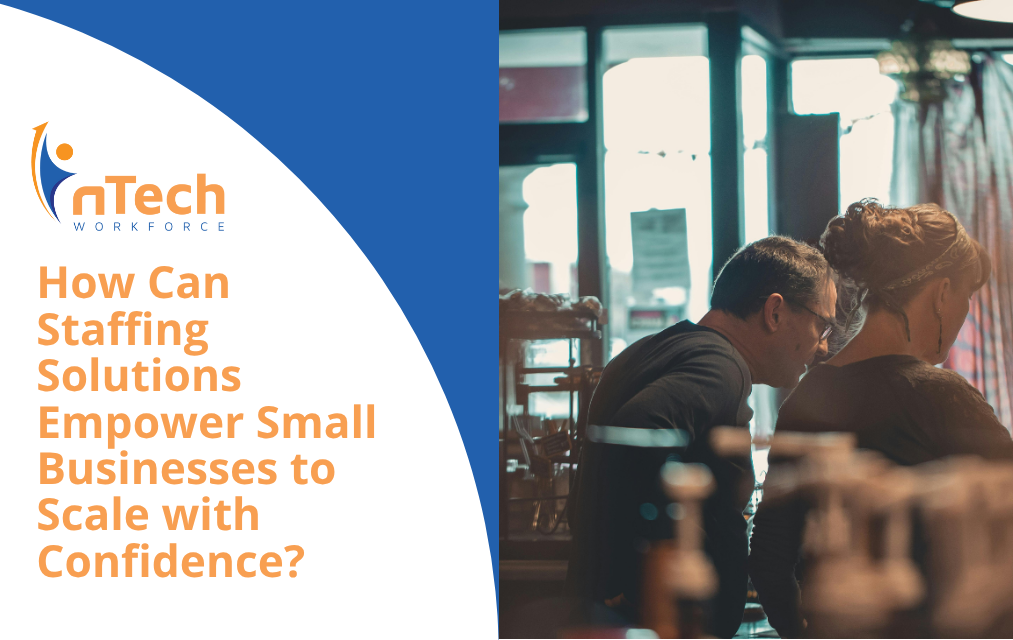When it comes to onboarding, employee retention, and organizational satisfaction are the main priority. So how can business leaders ensure the success of employee onboarding and avoid the common pitfalls that often come with new hire onboarding?
In this edition of nSider, Andrea Briere, People Operations Lead at nTech Workforce shares how employee onboarding can result in a resounding success.
Why Is Effective Onboarding Important?
One of the most important reasons for an effective onboarding process is to “relay the expectations of the position and the company,” says Andrea, after which it provides “an introduction of what your company is like, and it’s the first impression an employee has when they’re working with you.”
The hiring and onboarding processes set the stage and the standards that workers will hold potentially for the entire term of their employment.
Some would argue that an effective onboarding process is the key to improved productivity. As many as 81% of new hires felt overwhelmed by onboarding processes, which is not an ideal footing for starting in a new position.
What Are Some Components of an Effective Onboarding Program?
According to Andrea, “Communication at the base of everything in relationships. It is so important.” Starting with a solid footing of open communication is one of the best ways to begin the onboarding process.
“If you’re onboarding with a company and you feel isolated because no one’s reached out to you, or no one has touched base to see how you’re doing, are you going to feel engaged? Are you going to feel tied to the company culture? Probably not,” Andrea notes.
So how can leaders provide effective employee onboarding to maximize employee retention and organizational satisfaction?
Accessibility can be a challenge, especially for remote workers, so Andrea recommends that the team "email, call, or text to check in, keep up lines of communication, and demonstrate an open-door policy."
What Are Some Onboarding Challenges and How Do You Overcome Them?
One of the biggest challenges for HR departments with onboarding is overwhelming your candidate or new hire with too much information, or not giving them enough. This is only further complicated by the inevitable challenges that hiring managers face.
- Overwhelming Prospective Hires: Within the hiring process, “some companies require extensive background checks, paperwork, and other components of pre-onboarding that can be discouraging to people sometimes from even going through with an offer,” reports Andrea. “Making sure that you’re not confusing them or asking too much of the candidate even before they’re fully onboarded” can be a big obstacle, according to Andrea.
- Losing Out to Another Job: Another challenge can be the fact that “the job market can be competitive, and we can have people who have multiple offers coming at them,” says Andrea, “so sometimes you do see where someone accepts an offer, and they start the pre-onboarding process and then, five days later, they get an offer that they like more, and they happen to take it.” Ultimately, HR departments have to remain adaptable and flexible while still keeping the lines of communication open with the currently onboarding candidate.
- Unresponsiveness: During the new hire onboarding process, there are instances when it becomes challenging to receive timely responses from the new employees, even for simple check-ins. According to Andrea, who has gained experience in handling this situation, employers need to remember that these individuals might already be occupied with their work. To address this, she suggests utilizing text messaging as a means of communication, as some people may not regularly check their emails, but are more responsive to text messages. This tactic has proven effective for her and her team when there is a need to reach someone urgently.
How Do You Measure Success With Onboarding?
The goal is always for employee retention and organizational satisfaction. So, how can we know if the onboarding process effectively reached these?
“It’s always going to be something tough to measure, and it’s something that companies will have to focus on continuously to make sure that they have a great onboarding experience for people,” says Andrea, adding, “For my team, the way we measure success is with employee retention and engagement. We focus on reducing negative attrition.”
One benchmark to look out for is the first 60 days. It is common that “between their first days to day 60, you will know if they are going to stay in a position or not, and having an effective onboarding experience can make or break that decision.”
If you’re looking to hire and need support with the onboarding process and beyond - or if you are looking for more information about HR, hiring, or contingent staff management - reaching out to nTech Workforce can help provide a path for success.





